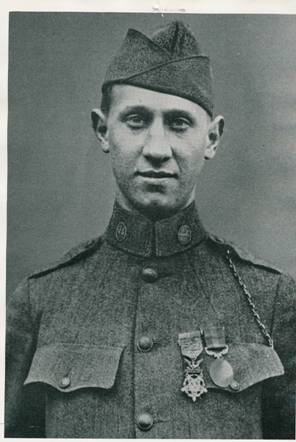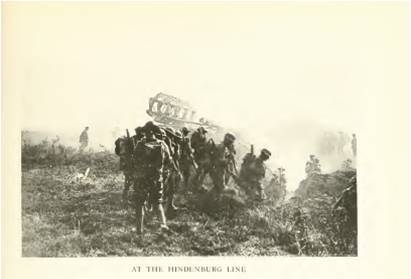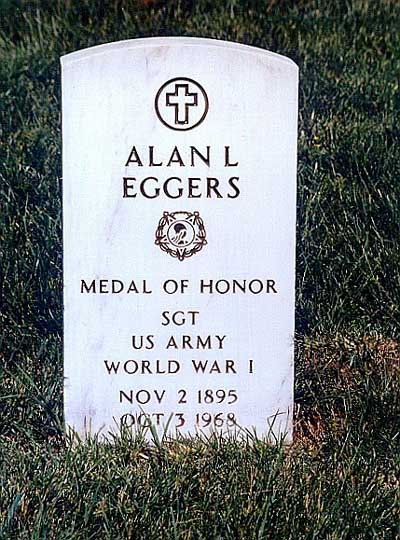Contributed by James Patton
 |
Yesterday, Roads to the Great War featured cartoonist Raeburn Van Buran of New York's 7th Infantry from the National Guard. Today we feature another alumnus of the "Silk Stocking Regiment." Alan Eggers was born in 1895 at Saranac Lake, NY. His youth was spent in Summit, NJ, and he attended Cornell University from 1915 to 1917, leaving before the end of his second year to join the 7th Regiment NYNG. He was one of the group called The Summit Gunners, which became the nucleus of the 107th Machine Gun Co. Three men from this unit — Eggers, Sgt. John Latham and Cpl. Thomas O’Shea — received Medals of Honor after the only instance in the war where three medals were awarded for the same action.
On 29 September 1918 the 107th MG Co. was part of the assault on the Hindenburg Line at the St. Quentin Canal Tunnel. From the start things didn’t go well. The Medal of Honor citation reads:
Becoming separated from their platoon by a smoke barrage, Sgt. Alan L. Eggers, Sgt. John C. Latham and Cpl. Thomas E. O'Shea took cover in a shell hole well within the enemy's lines. Upon hearing a call for help from an American tank, which had become disabled 30 yards from them, the 3 soldiers left their shelter and started toward the tank, under heavy fire from German machine-guns and trench mortars. In crossing the fire-swept area Cpl. O'Shea was mortally wounded, but his companions, undeterred, proceeded to the tank, rescued a wounded officer, and assisted 2 wounded soldiers to cover in a sap of a nearby trench. Sgt. Eggers and Sgt. Latham then returned to the tank in the face of the violent fire, dismounted a Hotchkiss gun, and took it back to where the wounded men were, keeping off the enemy all day by effective use of the gun and later bringing it, with the wounded men, back to our lines under cover of darkness.
 |
It is heroic to risk your life to rescue a comrade, especially under fire. For this reason alone the deeds of these three warranted consideration for the Medal of Honor. Moreover, Latham and Eggers made more than one trip under fire to the disabled tank.
 |
Furthermore, for several hours the left flank of the attack was held by the M1909 Hotchkiss manned by Latham and Eggers. By effectively deploying this gun and manning it under heavy fire, all the while out of contact with their own forces, they played a key role in the eventual success of the attack, which was another act of heroism.
Finally, they managed to extract themselves, three wounded men (two of whom couldn’t walk without help) and the 27-pound machine gun (presumably with ammunition), and somehow found the stabilized positions, in the dark. This was a third act of heroism.
Eggers returned to the Cornell Law School, graduating in 1921. He worked on Wall Street until 1959. He married in 1935 and had two sons. He died in 1968 and is buried in Arlington National Cemetery.

Another Medal of Honor was also awarded to the 107th on that day, Sept. 29, to Italian immigrant Michael Valente. That was four Medals of Honor, quite an accomplishment for those silk stocking soldiers. -- Stephen L. Harris
ReplyDelete